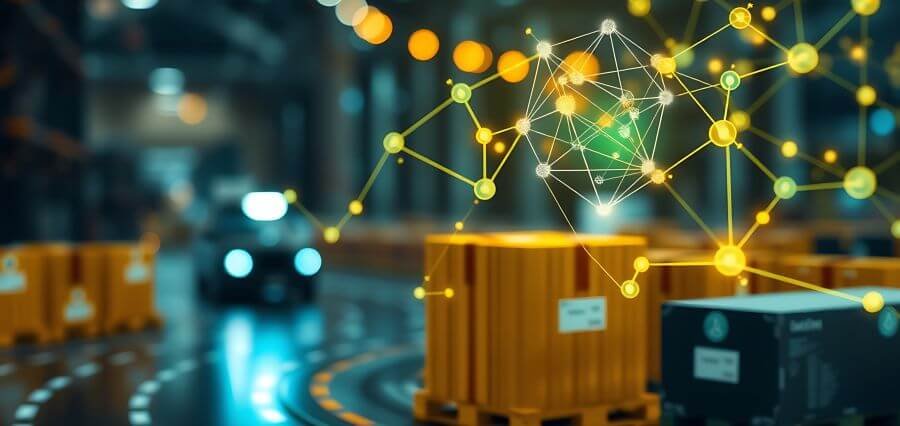Supply chains around the world are being redefined. Volatility in demand, skills shortages, and increasing expectations from customers for speed and visibility have compelled firms to transform. The solution, most frequently, lies at the intersection of robotics and artificial intelligence (AI). On their own, they’re transforming logistics, warehouses, and procurement—giving birth to efficiency, resiliency, and agility in the disruption era.
AI + Robotics in Logistics: More Intelligent, Speedier, and Resilient
Logistics—the lifeblood of international trade—has swiftly been automating. Robotics and artificial intelligence are making life easier for things like route optimization and end-mile delivery.
Case Example: UPS
UPS also implemented AI-driven route optimization software named ORION (On-Road Integrated Optimization and Navigation). It considers traffic, weather, and delivery data to provide the most efficient routes to deliver. Along with robot sorting facilities, it saved fuel and even minimized delivery time.
Case Example: Amazon Prime Air
Amazon has tested autonomous drones for last-mile delivery. With AI-based navigation technology, drones can deliver light packets in 30 minutes at less delivery time and transportation expense.
Impact:
- Lower fuel consumption and carbon footprint.
- Enhanced peak-demand delivery.
- Driver shortage immunization.
Here, AI is the “brain” that makes the decision on logistics and robotics is the “muscle” that executes it in large quantities.
AI + Robotics Warehousing: Reimagining Efficiency
Warehousing, which was once a time-consuming process, sorting, picking, and packing being hectic work. AI robots are now revolutionizing the task by designing intelligent warehouses that are maximizing speed as well as accuracy.
Case Example: Amazon Robotics
Amazon warehouses employ more than 750,000 self-directed robots who aid workers. Robots deliver shelves to workers to reduce time and boost productivity. Software powered by artificial intelligence determines what goes where, depending on shipping velocity and forecasted demand.
Case Example: DHL Supply Chain
DHL utilizes technology in the form of computers and robots which are AI-enabled to pick specially shaped products. The robots carry out challenging tasks which others had not automated. AI is also forward-looking, pre-stocking needed stock in advance and facilitating dynamic optimisation of storage space by DHL.
Impact:
- Effective on-time order picking with less human errors.
- Reduced operating cost through automation of repetitive activities.
- Enhanced employee safety by reducing physical workload.
Smart warehouses are a hybrid future in which people are focused on problem-solving and exception handling while robots are doing repeat precision work.
AI + Robotics in Procurement: Smart Sourcing and Risk Management
Procurement, though intangible compared to manufacturing, is part of supply chains. AI-driven analytics and robotic process automation (RPA) are helping companies to automate contracts, supplier management, and sourcing.
Case Example: Unilever
Unilever leverages AI-powered procurement platforms to sort through supplier data, identify risks, and track sustainability performance. The platform identifies which suppliers are most suited for cost, quality, and ESG requirements.
Case Example: IBM Sterling Supply Chain
IBM’s AI-powered procurement platform is supported by robotic process automation to automate approval of contracts, invoices, and supplier onboarding. It minimizes paperwork and streamlines procurement cycles.
Impact:
- Current visibility into suppliers’ risk.
- Reduced cost through best-sourcing.
- Enhanced procurement cycles with less error.
AI renders the procurement activity strategic in nature, decision-makers experiencing exposure of risk without compromising on the freedom of supplier choice.
Supply Chain Automation Benefit
From purchasing to logistics, AI and robotics combined bring measurable advantages:
- Economic Operations – Reduced human intervention and greater output.
- Flexibility and Resilience – Quick response to disruptions like pandemics or geopolitics tensions.
- Sustainability – Shorter paths, wastage reduced, and less energy consumption.
- Cost Savings – Lean operation and robotics of bulk operations.
- Customer Satisfaction – Time saved and fewer errors generate trust and loyalty.
Challenges and Considerations
Even though there is huge potential, companies that aim to enter supply chains with robots and AI have to overcome many challenges:
- High Initial Costs: Higher investment has to be put into automation infrastructure.
- Reskilling: Workers worry about losing their jobs; reskilling will provide human-robot cooperation balance.
- Cybersecurity Risks: Deep digitization subjects supply chains to cybersecurity risks.
- Jurisdictional and Ethical Concerns: Drone delivery, self-driving cars, and AI-based procurement will have to combat changing legal boundaries.
Firms that see automation as human-machine collaboration can expect such concerns addressed.
The Future: Self-Sustaining Supply Chains
The next few years will see robotics and artificial intelligence stepping into the limelight in the evolution to autonomous supply chains. Some of the future possibilities are:
- Autonomous long-haul logistics trucking and shipping fleets.
- Dynamic, real-time predictive digital twin simulation of supply chain status.
- Cobots (collaborative robots) that learn dynamically to fit an individual’s workflow in a warehouse.
- Autonomous self-tuning procurement systems capable of learning buying tactics independently.
The future is not efficiency, it’s resiliency. In the uncertain world, robotics and AI prepare supply chains to anticipate disruptions, respond in real time, and offer continuity.
Conclusion
The synergy of robotics and AI revolutionizes supply chains in procurement, warehousing, and logistics. UPS, Amazon, Unilever, and DHL show how automation does not merely save money—it sparks customer satisfaction, sustainability, and resilience.
As businesses keep rolling forward, it is no longer if they are going to automate but when and in an ethical way. Businesses that think of AI-based automation as a strategy will not only survive disruption but ride the next global business wave.




